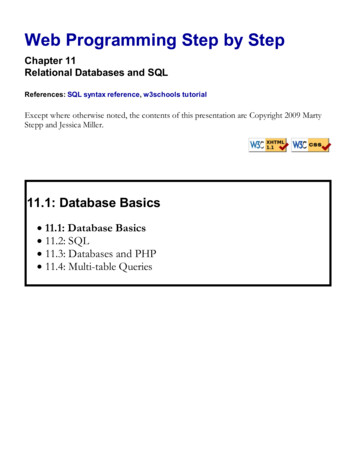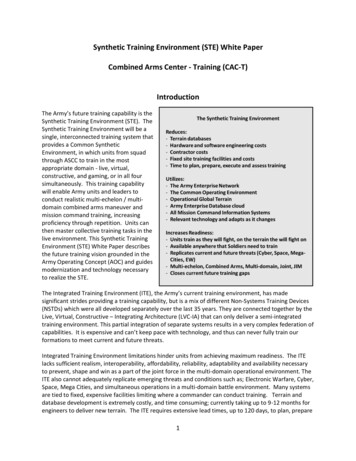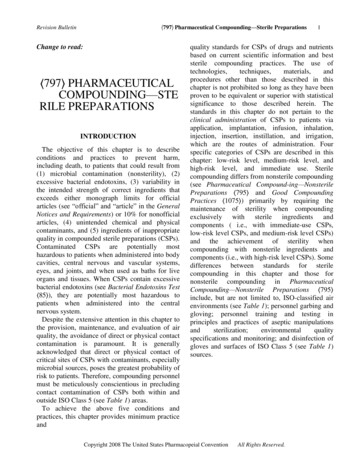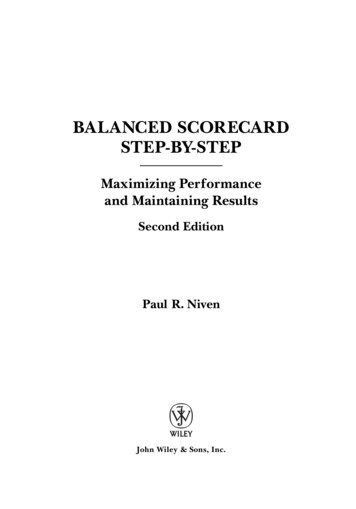
Transcription
Web Programming Step by StepChapter 11Relational Databases and SQLReferences: SQL syntax reference, w3schools tutorialExcept where otherwise noted, the contents of this presentation are Copyright 2009 MartyStepp and Jessica Miller.11.1: Database Basics11.1: Database Basics11.2: SQL11.3: Databases and PHP11.4: Multi-table Queries
Relational databasesrelational database: A method of structuring data as tables associated to each other byshared attributes.a table row corresponds to a unit of data called a record; a column corresponds to anattribute of that recordrelational databases typically use Structured Query Language (SQL) to define,manage, and search dataWhy use a database? (11.1.1)powerful: can search it, filter data, combine data from multiple sourcesfast: can search/filter a database very quickly compared to a filebig: scale well up to very large data sizessafe: built-in mechanisms for failure recovery (e.g. transactions)multi-user: concurrency features let many users view/edit data at same timeabstract: provides layer of abstraction between stored data and app(s)many database programs understand the same SQL commands
Database softwareOracleMicrosoft SQL Server (powerful) and Microsoft Access (simple)PostgreSQL (powerful/complex free open-source database system)SQLite (transportable, lightweight free open-source database system)MySQL (simple free open-source database system)many servers run "LAMP" (Linux, Apache, MySQL, and PHP)Wikipedia is run on PHP and MySQLwe will use MySQL in this courseExample world database (11.1.2)CountriesOther columns: region, surface area, life expectancy, gnp old, local name, government form, capital, code2codenamecontinentAFG Afghanistan AsiaNLD Netherlands Europe.independance pulationgnphead of state227200005976.0Mohammad Omar15864000371362.0 Beatrix.CountriesLanguagesUSApopulation country codeAFG8008278NLD.California 3694820.country lTT.percentage52.495.6.
11.2: SQL11.1: Database Basics11.2: SQL11.3: Databases and PHP11.4: Multi-table QueriesSQL basicsSELECT name FROM Cities WHERE id 17;INSERT INTO Countries VALUES ('SLD', 'ENG', 'T', 100.0);Structured Query Language (SQL): a language for searching and updating a databasea standard syntax that is used by all database software (with minor incompatiblities)a declarative language: describes what data you are seeking, not exactly how to find it
Issuing SQL commands directly in MySQL (11.2.1- 11.2.2)SHOW DATABASES;USE database;SHOW TABLES;SSH to a web server, then type: mysql -u yourusername -pPassword:Welcome to the MySQL monitor.Commands end with ; or \g.mysql USE world;Database changedmysql SHOW TABLES; -------------------- Cities Countries CountriesLanguages -------------------- 3 rows in set (0.00 sec)The SQL SELECT statement (11.2.3)SELECT column(s) FROM table;SELECT name, code FROM Countries;nameChinaUnited the SELECT statement searches a database and returns a set of resultsthe column name(s) written after SELECT filter which parts of the rows arereturnedtable and column names are case-sensitive
SELECT * FROM table; keeps all columns
The DISTINCT modifierSELECT DISTINCT column(s) FROM table;SELECT languageFROM amentoSpanishSpanishSpanish.SELECT DISTINCT languageFROM panish.eliminates duplicates from the result setThe WHERE clause (11.2.4)SELECT column(s) FROM table WHERE condition(s);SELECT name, population FROM Cities WHERE country code "FSM";name populationWeno 22000Palikir 8600WHERE clause filters out rows based on their columns' data valuesin large databases, it's critical to use a WHERE clause to reduce the result set sizesuggestion: when trying to write a query, think of the FROM part first, then the WHEREpart, and lastly the SELECT part
More about the WHERE clauseWHERE column operator value(s)SELECT name, gnp FROM Countries WHERE gnp 2000000;codeJPNDEUUSA.nameJapanGermanyUnited States.gnp3787042.002133367.008510700.00.the WHERE portion of a SELECT statement can use the following operators: , , , , : not equalBETWEEN min AND maxLIKE patternIN (value, value, ., value)Multiple WHERE clauses: AND, ORSELECT * FROM Cities WHERE code 'USA' AND population 2000000;id379337943795.nameNew YorkLos AngelesChicago.country codeUSAUSAUSA.districtNew 6016.multiple WHERE conditions can be combined using AND and OR
Approximate matches: LIKEWHERE column LIKE patternSELECT code, name, population FROM Countries WHERE name LIKE 'United%'codeAREGBRUSAUMInameUnited Arab EmiratesUnited KingdomUnited StatesUnited States Minor Outlying Islandspopulation2441000596234002783570000LIKE 'text%' searches for text that starts with a given prefixLIKE '%text' searches for text that ends with a given suffixLIKE '%text%' searches for text that contains a given substringSorting by a column: ORDER BY (11.2.5)ORDER BY column(s)SELECT code, name, population FROM CountriesWHERE name LIKE 'United%' ORDER BY population;codeUMIAREGBRUSAnameUnited States Minor Outlying IslandsUnited Arab EmiratesUnited KingdomUnited Statespopulation0244100059623400278357000can write ASC or DESC to sort in ascending (default) or descending order:SELECT * FROM Countries ORDER BY population DESC;can specify multiple orderings in decreasing order of significance:SELECT * FROM Countries ORDER BY population DESC, gnp;
The SQL INSERT statement (11.2.6)INSERT INTO tableVALUES (value, value, ., value);INSERT INTO studentVALUES (789, "Nelson", "muntz@fox.com");adds a new row to the given tableThe SQL UPDATE and DELETE statementsUPDATE tableSET column value,.,column valueWHERE condition;DELETE FROM tableWHERE condition;UPDATE studentSET email "lisasimpson@gmail.com"WHERE SID 888;DELETE FROM student WHERE SID 800;modifies or deletes an existing row(s) in a table
11.3: Databases and PHP11.1: Database Basics11.2: SQL11.3: Databases and PHP11.4: Multi-table QueriesPHP MySQL functionsnamedescriptionmysql connectconnects to a database servermysql select dbchooses which database on server to use (similarto SQL USE database; command)mysql queryperforms a SQL query on the databasemysql real escape stringencodes a value to make it safe for use in a querymysql fetch array, .returns the query's next result row as anassociative arraymysql closecloses a connection to a database
Complete PHP MySQL example# connect to world database on local computer db mysql connect("localhost", "traveler", "packmybags");mysql select db("world");# execute a SQL query on the database results mysql query("SELECT * FROM Countries WHERE population 100000000;"# loop through each countrywhile ( row mysql fetch array( results)) {? li ? row["name"] ? , ruled by ? row["head of state"] ? /li ?php}? Connecting to MySQL: mysql connect (11.3.1)mysql connect("host", "username", "password");mysql select db("database name");# connect to world database on local computermysql connect("localhost", "traveler", "packmybags");mysql select db("world");mysql connect opens connection to database on its serverany/all of the 3 parameters can be omitted (default: localhost, anonymous)mysql select db sets which database to examine
Performing queries: mysql query (11.3.2)mysql connect("host", "username", "password");mysql select db("database name"); results mysql query("SQL query");. results mysql query("SELECT * FROM Cities WHERE code 'USA'AND population 2000000;");mysql query sends a SQL query to the databasereturns a special result-set object that you don't interact with directly, but instead passto later functionsSQL queries are in " ", end with ;, and nested quotes can be ' or \"Result rows: mysql fetch arraymysql connect("host", "username", "password");mysql select db("database name"); results mysql query("SQL query");while ( row mysql fetch array( results)) {do something with row;}mysql fetch array returns one result row as an associative arraythe column names are its keys, and each column's values are its valuesexample: row["population"] gives the population from that row of theresults
Error-checking: mysql error (11.3.3)if (!mysql connect("localhost", "traveler", "packmybags")) {die("SQL error occurred on connect: " . mysql error());}if (!mysql select db("world")) {die("SQL error occurred selecting DB: " . mysql error());} query "SELECT * FROM Countries WHERE population 100000000;"; results mysql query( query);if (! results) {die("SQL query failed:\n query\n" . mysql error());}SQL commands can fail: database down, bad password, bad query, .for debugging, always test the results of PHP's mysql functionsif they fail, stop script with die function, and print mysql error result to seewhat failedgive a descriptive error message and also print the query, if anyComplete example w/ error checking# connect to world database on local computercheck(mysql connect("localhost", "traveler", "packmybags"), "connect");check(mysql select db("world"), "selecting db");# execute a SQL query on the database query "SELECT * FROM Countries WHERE population 100000000;"; results mysql query( query);check( results, "query of query");# loop through each countrywhile ( row mysql fetch array( results)) {? li ? row["name"] ? , ruled by ? row["head of state"] ? /li ?php}# makes sure result is not false/null; else prints errorfunction check( result, message) {if (! result) {die("SQL error during message: " . mysql error());}}?
Other MySQL PHP functionsnamedescriptionmysql num rowsreturns number of rows matched by the querymysql num fieldsreturns number of columns per result in the querymysql list dbsreturns a list of databases on this servermysql list tablesreturns a list of tables in current databasemysql list fieldsreturns a list of fields in the current datacomplete list11.4: Multi-table Queries11.1: Database Basics11.2: SQL11.3: Databases and PHP11.4: Multi-table Queries
Example simpsons x.comMilhouse teachersidname1234 Krabappel5678 Hoover9012 nce 142ComputerScience 143ComputerScience190MInformatics100teacher id123456789012student id123123456888888404gradescourse id100011000210001100021000310004gradeBCB A A D 1234Querying multi-table databasesWhen we have larger datasets spread across multiple tables, we need queries that can answerhigh-level questions such as:What courses has Bart taken and gotten a B- or better?What courses have been taken by both Bart and Lisa?Who are all the teachers Bart has had?How many total students has Ms. Krabappel taught, and what are their names?To do this, we'll have to join data from several tables in our SQL queries.
Cross product with JOIN (11.4.1)SELECT column(s) FROM table1 JOIN table2;SELECT * FROM students JOIN saBartRalphemailstudent idbart@fox.com123ralph@fox.com123milhouse@fox.com 123lisa@fox.com123bart@fox.com123ralph@fox.com123. (24 rows returned)course id100011000110001100011000210002gradeBBBBCCcross product or Cartesian product: combines each row of first table with each rowof secondproduces M * N rows, where table 1 has M rows and table 2 has Nproblem: produces too much irrelevant/meaningless dataJoining with ON clauses (11.4.2)SELECT column(s)FROM table1JOIN table2 ON condition(s).JOIN tableN ON condition(s);SELECT *FROM studentsJOIN grades ON id student id;join: a relational database operation that combines records from two or more tables ifthey satisfy certain conditionsthe ON clause specifies which records from each table are matchedoften the rows are linked by their key columns
Join exampleSELECT *FROM studentsJOIN grades ON id student lhouse@fox.comlisa@fox.comlisa@fox.comstudent id123123404456888888course id100011000210004100011000210003gradeBCD B A A table.column can be used to disambiguate column names:SELECT *FROM studentsJOIN grades ON students.id grades.student id;Filtering columns in a joinSELECT name, course id, gradeFROM studentsJOIN grades ON students.id student id;nameBartBartRalphMilhouseLisaLisacourse id100011000210004100011000210003gradeBCD B A A if a column exists in multiple tables, it may be written as table.column
Giving names to tablesSELECT name, g.*FROM students sJOIN grades g ON s.id g.student id;nameBartBartRalphMilhouseLisaLisastudent id123123404456888888course id100011000210004100011000210003gradeBCD B A A can give names to tables, like a variable name in Javato specify all columns from a table, write table.*Filtered join (JOIN with WHERE) (11.4.3)SELECT name, course id, gradeFROM students sJOIN grades g ON s.id g.student idWHERE s.id 123;name course id gradeBart 10001BBart 10002CFROM / JOIN glue the proper tables together, and WHERE filters the resultswhat goes in the ON clause, and what goes in WHERE?ON directly links columns of the joined tablesWHERE sets additional constraints such as particular values (123, 'Bart')
Multi-way joinSELECT c.nameFROM courses cJOIN grades g ON g.course id c.idJOIN students bart ON g.student id bart.idWHERE bart.name 'Bart' AND g.grade 'B-';nameComputer Science 142grade column sorts alphabetically, so grades better than B- are ones itA suboptimal queryWhat courses have been taken by both Bart and Lisa?SELECT bart.course idFROM grades bartJOIN grades lisa ON lisa.course id bart.course idWHERE bart.student id 123AND lisa.student id 888;problem: requires us to know Bart/Lisa's Stud
11.2: SQL 11.3: Databases and PHP 11.4: Multi-table Queries PHP MySQL functions name description mysql_connect connects to a database server mysql_select_db chooses which database on server to use (similar to SQL USE database ; command) mysql_query performs a SQL query on the database











